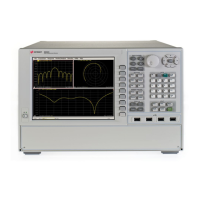Service Guide N5227-90001 5-5
PNA Series Microwave Network Analyzers Theory of Operation
N5227A Network Analyzer System Operation
Synthesized Source Group
The built-in synthesized source generates a swept, stepped, or continuous wave (CW) signal in the
frequency ranges as listed in the Data Sheet and Technical Specifications documents, available online at:
http://literature.cdn.keysight.com/litweb/pdf/N5227-90002.pdf and
http://literature.cdn.keysight.com/litweb/pdf/N5227-90003.pdf.
1
The source group provides five signals:
an LO signal and four incident signals. The LO signal and the four incident signals are offset in frequency by
the receiver IF of 7.438 MHz (at tuned frequencies below 53 MHz the IF and the offset is 0.826 MHz).
The LO signal is sent directly to the mixers in the receiver group. The incident signals are routed to the front
panel test ports and then to the device under test (DUT) as the test signal. A portion of each incident signal
is coupled off (in the signal separation group) and sent to the mixers in the receiver group as reference
signals. These reference signals are compared (mixed) with the LO signal in the receiver group to produce
the 7.438 MHz (or 0.826 MHz at frequencies below 53 MHz) IF signal.
The incident signal output power is leveled by an internal automatic leveling control (ALC) circuit. The
maximum output power level of the network analyzer at the test ports is shown in the Data Sheet and
Technical Specifications documents
1
.
Refer to “Synthesized Source Group Operation” on page 5-7.
Signal Separation Group
Each of the incident signals from the source group is separated into a reference path and a test path. The
reference signal is transmitted to the receiver group. The test signal is transmitted through—and reflected
from—the DUT and is then transmitted to the receiver group.
The signal separation group includes:
• RF path switching to allow forward and reverse measurements
• external connections for the DUT (configurable test set)
• optional step attenuators in the source and receiver paths
• optional bias tees
Refer to “Signal Separation Group Operation” on page 5-20.
1. For frequency ranges and maximum output power levels, refer to the section “Test Port Output” in the Data
Sheet and Technical Specifications documents (see hyperlinks above).

